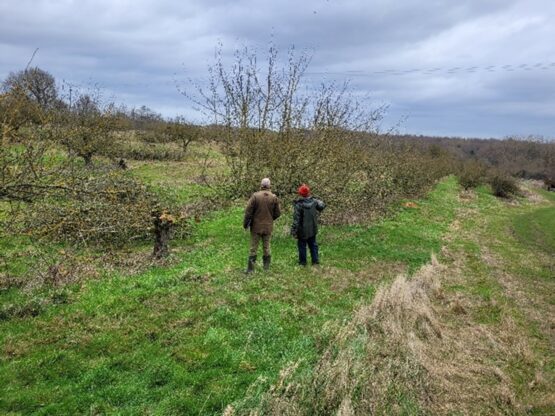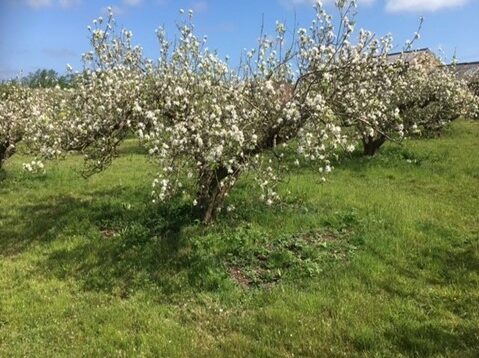Farming in Protected Landscapes Case Study:
Dodnash Orchards: Regeneration

Dodnash Fruit Farm was awarded £5,949 in 2021, and £23,653 in 2022/23 to
help rejuvenate their orchards.
Some fruit trees on the farm are old and completely unproductive as they are so over-grown, meaning the orchards get little sunlight. Orchards were a feature of this area of Suffolk but many are declining or have been removed from the landscape.
Early Objectives
To regenerate the old orchards at Dodnash Fruit Farm through thinning and pruning to enable a commercially viable crop to be harvested and see the
orchards preserved in the landscape.
The Worcester Orchards were planted by Prisoners Of War, after the Second World War, and are a valued local feature. Other orchards are roughly 25 years old.
The old trees were not providing any crop at all due to over-crowding and lack of pruning. Some were dying and others were weak and at risk of degenerating further, with broken and thinning branches as they try to obtain sufficient light.
Machinery to treat and harvest the trees can not fit between the rows, and any fruit is therefore lost to pests. The farm is organic, therefore cannot use chemicals to control insects such as the coddling moth, so disease was able to get into the trees. The soil was also in poor health due to a lack of organic matter, so it needed investigation and improvement.
The farm is run in a nature friendly way and this is further supported by the recent addition of wildlife features on the farm. For example, three renovated ponds, mainly to attract great-crested newts, and hedge and woodland/shrub planting to attract turtledoves, plus housing for hedgehogs.
Several beehives are positioned in the orchard to aid fertilisation and increase biodiversity. This activity will increase now the orchards are flourishing again. Suffolk & Essex Coast & Heaths National Landscape volunteers have been working on the farm installing stag beetle pyramids to encourage these rare creatures – Britain’s largest beetle.
The Farming in Protected Landscapes team work closely with the farmer to monitor how the project work is progressing. They are discussing how planting new fruit trees will infill gaps left by old trees which have been removed. Rare native varieties will be used to preserve them.

Work going forwards
The third stage of the project was to remove hybrid Poplar trees at the boundary of the orchards and adjacent woodland to allow for new fencing to prevent muntjac deer and rabbit damaging the orchards and newly planted trees.
The felled trees were replaced with native trees, following recommendations from Suffolk Wildlife Trust.
Cut wood is left as habitat for wildlife to aid biodiversity by encouraging insects, which will in turn encourage a wide range of birds, such as lesser spotted woodpecker, bullfinch, redstart and, in winter, fieldfare and redwing. Bats and amphibians are also present on the farm, encouraged by large natural ponds adjacent to the orchards.
Increased fruit production will encourage small mammals, such as hedgehogs and mice and in turn larger mammals such as foxes, and badgers and birds of prey such as barn owls, again these species are returning to the orchards and this second stage of the project will encourage and sustain this. Chipping fruit tree clippings were used as mulch for newly planted fruit trees to improve the soil, help retain rainwater and aid biodiversity.

Outcomes
The farm is now able to harvest fruit for sale and to produce organic juice. As there is a commercial gain for the farmer, the Farming in Protected Landscapes programme funded 60% of the costs.
Grants also follow the Defra Countryside Stewardship rates for standard work, such as fencing. Protecting farm sustainability is an important outcome for projects, as is enabling farms to provide employment opportunities for local people.
The newly-pruned fruit trees in blossom this spring, providing a beautiful view in the landscape. You may even see them from the trainline to London!
